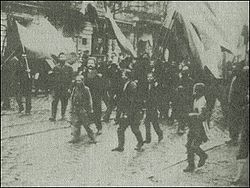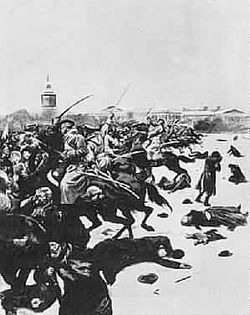Bloody Sunday (1905)


Bloody Sunday (Russian: Кровавое воскресенье) was a massacre on January 22 [O.S. January 9] 1905 in St. Petersburg, Russia, where unarmed, peaceful demonstrators marching to present a petition to Tsar Nicholas II were gunned down by the Imperial Guard. The march was organized by Father Gapon, who had collaborated with Sergei Zubatov of the Okhrana, the Tsarist secret police, to create workers' organizations[1] and thus considered by some to be its agent provocateur. Bloody Sunday was an event with grave consequences for the Tsarist regime, as the disregard for ordinary people shown by the massacre undermined support for the state.
Contents |
Preludes
The previous December, a strike occurred at the Putilov plant, which made military orders during Russo-Japanese War. Sympathy strikes in other parts of the city raised the number of strikers above 80,000. By January 8, the city had no electricity and no newspapers. All public areas were declared closed. Father Gapon, a Russian priest who was concerned about the conditions experienced by the working and lower classes, organized a peaceful "workers' procession" to the Winter Palace to deliver a petition to the Tsar that Sunday stating reforms they had desperately wanted. The petition, written by Gapon, made clear the problems and opinions of the workers and called for improved working conditions, fairer wages, and a reduction in the working day to eight hours. Other demands included an end to the Russo-Japanese War and the introduction of universal suffrage. However, the Tsar was in no condition to meet the demands of the workers due to the depression sweeping Russia. The procession was well stewarded by followers of Gapon and any terrorists and hot-heads were removed and all the participants checked for weapons. Chairman of the Council of Ministers Sergei Witte was implored not to act against the marchers. Troops had been deployed around the Winter Palace and at other key points. The Tsar left the city on January 8 for Tsarskoye Selo.
Bloody Sunday
On the Sunday, striking workers and their families gathered at six points in the city of St. Petersburg. They were organized and led by Father Gapon. Clutching religious icons and singing hymns and patriotic songs (particularly "God Save the Tsar"), a crowd of "more than 300,000"[2] proceeded without police interference towards the Winter Palace, the tsar's official residence. The demonstrators brought along their families in hope of seeing their Tsar and delivering the petition to him as they believed he would take into account their miseries and attempt to sort their problems for them. They believed it would be a peaceful and patriotic day during which they could pass on their petition to the tsar. The army pickets near the palace released warning shots, and then fired directly into the crowds to disperse them. Gapon was fired upon near the Narva Gate. Around forty people surrounding him were killed, but he was not injured.[3] Although the tsar had not been present at the Winter Palace at this time, he received the blame for the deaths, resulting in a surge of bitterness towards himself and his autocratic rule from the Russian people.

The number killed is uncertain but the tsar's officials recorded 96 dead and 333 injured; anti-government sources claimed more than 4,000 dead; moderate estimates still average around 1,000 killed or wounded, both from shots and trampled during the panic. Nicholas II described the day as "painful and sad".[4] As reports spread across the city, disorder and looting broke out. Gapon's Assembly was closed down that day, and Gapon quickly left Russia. Returning in October, he was assassinated by the order of the Combat Organization of the Socialist-Revolutionary Party after he revealed to his friend Pinhas Rutenberg that he was working for the Okhrana or Secret Police.[1]
This event inflamed revolutionary activities in Russia and contributed to the Revolution of 1905.
| “ |
Tolstoy was still subject to the emotion caused by one of the most tragical examples of this heroic non-resistance of a people the bloody manifestation of January 22nd in St. Petersburg, when an unarmed crowd, led by Father Gapon, allowed itself to be shot down without a cry of hatred or a gesture of self-defence. |
” |
|
— Romain Rolland, Life of Tolstoy |
||
See also
- Symphony No. 11 (Shostakovich)
References
- ↑ 1.0 1.1 Notes on Georgii Appolonovich Gapon (1870-1906), Northern Virginia Community College
- ↑ Gapon, Address to the Tsar, January 1905, in Ascher, The Revolution of 1905, Vol. 1
- ↑ Ascher, Abraham. The Revolution of 1905. Stanford, Calif.: Stanford UP, 1988. p. 91. Print
- ↑ Kurth, Peter. Tsar: the Lost World of Nicholas and Alexandra. Boston: Back Bay, 1998. p. 81